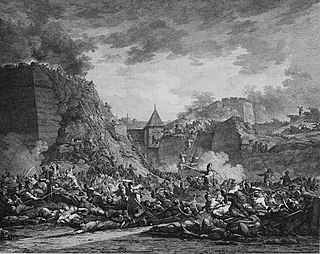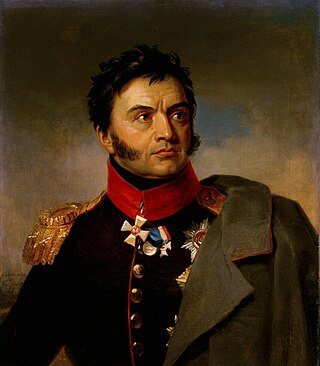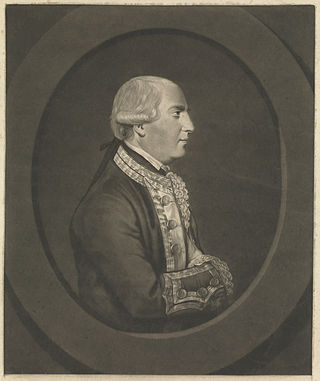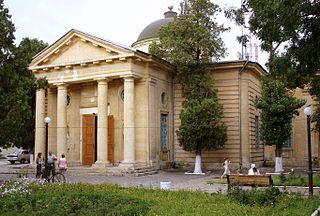Related Research Articles

Prince Michael Andreas Barclay de Tolly was an Imperial Russian soldier of Baltic German and Scottish origin, who was commander-in-chief and Minister of War of the Russian Empire during Napoleon's invasion in 1812 and the War of the Sixth Coalition. Barclay de Tolly, while serving as the minister of war in Russia, was responsible for the country's defense against Napoleon's invasion in June 1812. He held this position until the following year. During the invasion, Barclay de Tolly led one of the Russian armies and fought in battles at Ostrovno and Smolensk. He also took up a military role supporting Field Marshal Mikhail Kutuzov, who was leading the army in retreat from Napoleon's advance. Despite facing opposition from senior officers and public calls for his removal, Barclay de Tolly persevered under great stress. He distinguished himself in the Battle of Borodino on 7 September and helped the Russian forces withdraw strategically to save what remained of their troops. However, he was forced to leave the army in October 1812. Barclay implemented a number of reforms during this time that improved supply system in the army, doubled the number of army troops, and implemented new combat training principles. He is among the greatest military commanders in the Russian service of all time.

The Russo-Swedish War of 1788–1790 was fought between Sweden and Russia from June 1788 to August 1790. The war was ended by the Treaty of Värälä on 14 August 1790 and took place concomitantly with both the Austro-Turkish War (1788–1791), Russo-Turkish War (1787–1792) and Theatre War. The war was, overall, mostly insignificant for the parties involved.

Prince Grigory Aleksandrovich Potemkin-Tauricheski was a Russian military leader, statesman, nobleman, and favourite of Catherine the Great. He died during negotiations over the Treaty of Jassy, which ended a war with the Ottoman Empire that he had overseen.

The naval Battle of Fidonisi took place on 14 July 1788 (OS) between the fleets of the Russian Empire and the Ottoman Empire during the Russo-Turkish War (1787–1792) in the area of Snake Island, which in Greek was called Fidonisi (Φιδονήσι). It was a Russian victory.

The Russo-Turkish War of 1787–1792 involved an unsuccessful attempt by the Ottoman Empire to regain lands lost to the Russian Empire in the course of the previous Russo-Turkish War (1768–1774). It took place concomitantly with the Austro-Turkish War (1788–1791), Russo-Swedish War (1788–1790) and Theatre War.

Ochakiv, also known as Ochakov and Vozia, and Alektor, is a small city in Mykolaiv Raion, Mykolaiv Oblast (region) of southern Ukraine. It hosts the administration of Ochakiv urban hromada, one of the hromadas of Ukraine. Population: 13,663.

Cezayirli Gazi Hasan Pasha or Hasan Pasha of Algiers was an Ottoman Grand Admiral (1770–90), Grand Vizier (1790), and general in the late 18th century.

Nikolay Nikolayevich Raevsky was a Russian general and statesman who achieved fame for his feats of arms during the Napoleonic Wars. His family left a lasting legacy in Russian society and culture.

The siege of Ochakov or the siege of Özi was one of the major events of the Russo-Turkish War (1787–1792). It was known as "Özi Kuşatması" in Turkish.

Prince Sergei Grigorievich Volkonsky was a Russian Empire Major General and Decembrist from the aristocratic Volkonsky family.

John Elphinstone, also known as John Elphinston, was a senior British naval officer who worked closely with the Russian Navy after 1770, with approval from the Admiralty, during the period of naval reform under Russian Empress Catherine II. Together with the Scottish-born Samuel Greig, or Samuil Karlovich Greig, as he was known in Russia, and Admiral Sir Charles Knowles, Elphinstone was a member of the naval staff, headed by Count Alexei Grigoryevich Orlov, which, although it lacked naval experience, was able to defeat the Turkish fleet at the Battle of Chesma Bay, near Chios Island, off the far western coast of Turkey.

The Cathedral of St. Catherine is a religious building belonging to the Orthodox faith which is situated within the fortress of Kherson, Ukraine. It was built in 1781–1786, one of the earliest churches in New Russia. It is a domed sandstone structure with a Tuscan portico and heavily rusticated walls. The church was dedicated to Catherine of Alexandria, the patron saint of the reigning empress.

The Dnieper–Bug estuary, also called the Dniprovska Gulf, is an open estuary, or liman, of two rivers: the Dnieper and the Southern Bug. It is located on the northern coast of the Black Sea and is separated from it by the Kinburn Spit and the Cape of Ochakiv.
Events from the year 1799 in Russia

Events from the year 1790 in Russia
Events from the year 1789 in Russia
Scottish Russians are Russians with full Scottish ancestry. Scottish migration to Russia occurred primarily during the early-17th-century Polish–Muscovite War (1605–1618), Ingrian War (1610–1617) and Thirty Years' War (1618–1648). Some estimates of the number of Scottish settlers in Russia during the 17th century are as high as 100,000. This has led some demographers to believe that the current number of Scottish Russians could be up to 1-2 million. There are believed to be around 400 different Russian surnames that owe their names to Scottish ancestors.

Prince Mikhail Nikitich Volkonsky was a Russian statesman and military figure from the House of Volkonsky, General-in-Chief (1762), in 1771–1780 he was Commander-in-Chief in Moscow. The brother of General Alexei Volkonsky, uncle of Nastasya Ofrosimova.
References
![]() Media related to 1788 in Russia at Wikimedia Commons
Media related to 1788 in Russia at Wikimedia Commons